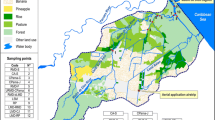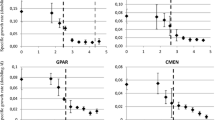Abstract
Species sensitivity distribution (SSD) is commonly used in prospective risk assessment to derive predicted no-effect concentrations, toxicity exposure ratios, and environmental quality standards for individual chemicals such as pesticides. The application of SSD in the retrospective risk assessment of chemical mixtures at the river basin scale (i.e., the estimation of “multiple substance potentially affected fractions” [msPAFs]) has been suggested, but detailed critical assessment of such an application is missing. The present study investigated the impact of different data validation approaches in a retrospective model case study focused on seven herbicides monitored at the Scheldt river basin (Belgium) between 1998 and 2009. The study demonstrated the successful application of the SSD approach. Relatively high impacts of herbicides on aquatic primary producers were predicted. Often, up to 40 % of the primary producer communities were affected, as predicted by chronic msPAF, and in some cases, the predicted impacts were even more pronounced. The risks posed by the studied herbicides decreased during the 1998–2009 period, along with decreasing concentrations of highly toxic pesticides such as simazine or isoproturon. Various data validation approaches (the removal of duplicate values and outliers, the testing of different exposure durations and purities of studied herbicides, etc.) substantially affected SSD at the level of individual studied compounds. However, the time-consuming validation procedures had only a minor impact on the outcomes of the retrospective risk assessment of herbicide mixtures at the river basin scale. Selection of the appropriate taxonomic group for SSD calculation and selection of the species-specific endpoint (i.e., the most sensitive or average value per species) were the most critical steps affecting the final risk values predicted. The present validation study provides a methodological basis for the practical use of SSD in the retrospective risk assessment of chemical mixtures.








Similar content being viewed by others
References
Aldenberg T, Jaworska JS (2000) Uncertainty of the hazardous concentration and fraction affected for normal species sensitivity distributions. Ecotoxicol Environ Saf 46:1–18. doi:10.1006/eesa.1999.1869
Aldenberg T, Luttik R (2002) Extrapolation factors for tiny toxicity data sets from species sensitivity distributions with known standard deviation. In: Posthuma L, Suter GW II, Traas TP (eds) Species sensitivity distributions in ecotoxicology. Lewis, Boca Raton, pp 103–118
Bachman J (2009) Use of probabilistic methods in environmental risk assessment—species sensitivity distribution (SSD) and HC5. Position paper. German Federal Environment Agency, Dessau
Beggel S, Werner I, Connon RE, Geist JP (2010) Sublethal toxicity of commercial insecticide formulations and their active ingredients to larval fathead minnow (Pimephales promelas). Sci Total Environ 408:3169–3175. doi:10.1016/j.scitotenv.2010.04.004
Brock TCM, Crum SJH, Deneer JW, Heimbach F, Roijackers RMM, Sinkeldam JA (2004) Comparing aquatic risk assessment methods for the photosynthesis-inhibiting herbicides metribuzin and metamitron. Environ Pollut 130:403–426. doi:10.1016/j.envpol.2003.12.022
Caquet T, Roucaute M, Mazzella N, Delmas F, Madigou C et al (2013) Risk assessment of herbicides and booster biocides along estuarine continuums in the Bay of Vilaine area (Brittany, France). Environ Sci Pollut Res 20:651–666. doi:10.1007/s11356-012-1171-y
Carafa R, Faggiano L, Real M, Munné A, Ginebreda A et al (2011) Water toxicity assessment and spatial pollution patterns identification in a Mediterranean River Basin District. Tools for water managment and risk analysis. Sci Total Environ 409:4267–4279. doi:10.1016/j.scitotenv.2011.06.053
Cedergreen N, Streibig JC (2005) The toxicity of herbicides to non-target aquatic plants and algae: assessment of predictive factors and hazard. Pest Manag Sci 61:1152–1160. doi:10.1002/ps.1117
Cedergreen N, Christensen AM, Kamper A, Kudsk P, Mathiassen SK, Streibig JC, Sorensen H (2008) A review of independent action compared to concentration addition as reference models for mixtures of compounds with different molecular target sites. Environ Toxicol Chem 28:1621–1632. doi:10.1897/07-474.1
Comte L, Lek S, de Deckere E, De Zwart D, Gevrey M (2010) Assessment of stream biological responses under multiple-stress conditions. Environ Sci Pollut Res 17:1469–1478. doi:10.1007/s11356-010-0333-z
Crane M, Newman MC (2000) What level of effect is a no observed effect? Environ Toxicol Chem 19:516–519. doi:10.1897/1551-5028(2000)019<0516:WLOEIA>2.3.CO;2
De Zwart D (2002) Observed regularities in species sensitivity distributions for aquatic species. In: Posthuma L, Traas TP, Suter GW II (eds) Species sensitivity distribution in ecotoxicology. Lewis, Boca Raton, pp 133–154
De Zwart D, Posthuma L (2005) Complex mixture toxicity for single and multiple species: proposed methodologies. Environ Toxicol Chem 24:2665–2676. doi:10.1897/04-639R.1
Duboudin CP, Ciffroy P, Magaud H (2004) Effects of data manipulation and statistical methods on species sensitivity distributions. Environ Toxicol Chem 23:489–499. doi:10.1897/03-15
EC (2003) Technical guidance document on risk assessment, part II. Bureau EC, Ispra
EC (2011) Technical guidance for deriving environmental quality standards. Guidance Document No. 27:204
US EPA (1985) Guidelines for deriving numerical national water quality criteria for the protection of aquatic organisms and their uses. PB85-227049. US Environmental Protection Agency National Technical Information Service, Springfield
Faggiano L, De Zwart D, García-Berthou E, Lek S, Gevrey M (2010) Patterning ecological risk of pesticide contamination at the river basin scale. Sci Total Environ 408:2319–2326. doi:10.1016/j.scitotenv.2010.02.002
Forbes VE, Calow P (2002) Species sensitivity distributions revisited: a critical appraisal. Hum Ecol Risk Assess 8:473–492. doi:10.1080/20028091057033
Fuerhacker M (2009) EU Water Framework Directive and Stockholm Convention—can we reach the targets for priority substances and persistent organic pollutants? Environ Sci Pollut Res 16:92–97. doi:10.1007/s11356-009-0126-4
Grist EPM, O’Hagan A, Crane M, Sorokin N, Sims I, Whitehouse P (2006) Bayesian and time-independent species sensitivity distributions for risk assessment of chemicals. Environ Sci Technol 40:395–401. doi:10.1021/es050871e
Hayashi TI, Kashiwagi N (2010) A Bayesian method for deriving species-sensitivity distributions: selecting the best-fit tolerance distributions of taxonomic groups. Hum Ecol Risk Assess 16:251–263. doi:10.1080/10807031003670279
Hayashi TI, Kashiwagi N (2011) A Bayesian approach to probabilistic ecological risk assessment: risk comparison of nine toxic substances in Tokyo surface waters. Environ Sci Pollut Res 18:365–375. doi:10.1007/s11356-010-0380-5
Hickey GL, Kefford BJ, Dunlop JE, Craig PS (2008) Making species salinity sensitivity distributions reflective of naturally occurring communities: using rapid testing and Bayesian statistics. Environ Toxicol Chem 27:2403–2411. doi:10.1897/08-079.1
Jager T (2012) Bad habits die hard: the NOEC’s persistence reflects poorly on ecotoxicology. Environ Toxicol Chem 31:228–229. doi:10.1002/etc.746
Kefford JB, Palmer PG, Jooste S, Warne MSJ, Nugegoda D (2005) What is meant by “95 % of species”? An argument for the inclusion of rapid tolerance testing. Hum Ecol Risk Assess 11:1025–1046. doi:10.1080/10807030500257770
Laskowski R (1995) Some good reasons to ban the use of NOEC, LOEC and related concepts in ecotoxicology. Oikos 73:140–144. doi:10.2307/3545738
Maltby L, Blake N, Brock TCM, Van den Brink PJ (2005) Insecticide species sensitivity distributions: importance of test species selection and relevance to aquatic ecosystems. Environ Toxicol Chem 24:379–388. doi:10.1897/04-025R.1
Maltby L, Brock TCM, Van den Brink PJ (2009) Fungicide risk assessment for aquatic ecosystems: importance of interspecific variation, toxic mode of action, and exposure regime. Environ Sci Technol 43:7556–7563. doi:10.1021/es901461c
Newman MC, Ownby DR, Mezin LCA, Powell DC, Christensen TRL et al (2000) Applying species-sensitivity distributions in ecological risk assessment: assumptions of distribution type and sufficient numbers of species. Environ Toxicol Chem 19:508–515. doi:10.1897/1551-5028(2000)019<0508:ASSDIE>2.3.CO;2
OECD (2006a) Guidelines for the testing of chemicals no. 221: Lemna sp. growth inhibition test. Organization for Economic Cooperation and Development, Paris
OECD (2006b) Series on testing and assessment no. 54: current approaches in the statistical analysis of ecotoxicity data: a guidance to application. Organization for Economic Cooperation and Development, Paris
OECD (2011) Guidelines for the testing of chemicals no. 201: freshwater alga and cyanobacteria, growth inhibition test. Organization for Economic Cooperation and Development, Paris
Pereira T, Cerejeira MJ, Espírito-Santo J (2000) Use of microbiotests to compare the toxicity of water samples fortified with active ingredients and formulated pesticides. Environ Toxicol 15:401–405. doi:10.1002/1522-7278(2000)15:5<401::AID-TOX7>3.0.CO;2-H
Posthuma L, Traas TP, Suter GW (2002) Species sensitivity distributions in ecotoxicology. Lewis, Boca Raton
Raimondo S, Vivian DN, Delos C, Barron MG (2008) Protectiveness of species sensitivity distribution hazard concentrations for acute toxicity used in endangered species risk assessment. Environ Toxicol Chem 27:2599–2607. doi:10.1897/08-157.1
Reade JPH, Cobb AH (2002) Herbicides: modes of action and metabolism. In: Naylor REL (ed) Weed management handbook. British Crop Protection Enterprises, Banchory, pp 134–170
RIZA (1999) Effect factors for the aquatic environment in the framework of LCA. RIVM, Netherlands
Rockström J, Steffen W, Noone K, Persson Å, Chapin FS et al (2009) Planetary boundaries: exploring the safe operating space for humanity. Ecol Soc 14:32. Available at http://www.ecologyandsociety.org/vol14/iss2/art32
Schuler LJ, Rand GM (2008) Aquatic risk assessment of herbicides in freshwater ecosystems of South Florida. Arch Environ Contam Toxicol 54:571–583. doi:10.1007/s00244-007-9085-2
Sijm DTHM, Van Wezel AP, Crommentuijn T (2002) Environmental risk limits in the Netherlands. In: Posthuma L, Traas TP, Suter GW II (eds) Species sensitivity distribution in ecotoxicology. Lewis, Boca Raton, pp 221–254
Silva E, Mendes MP, Ribeiro L, Cerejeira MJ (2012) Exposure assessment of pesticides in a shallow groundwater of the Tagus vulnerable zone (Portugal): a multivariate statistical approach (JCA). Environ Sci Pollut Res 19:2667–2680. doi:10.1007/s11356-012-0761-z
Smital T, Terzic S, Loncar J, Senta I, Zaja R et al (2012) Prioritisation of organic contaminants in a river basin using chemical analyses and bioassays. Environ Sci Pollut Res. doi:10.1007/s11356-012-1059-x
Solomon KR, Brock TCM, Zwart DD, Dyer SD (2008) Extrapolation in the context of criteria setting and risk assessment. In: Solomon KR, Brock TCM, De Zwart D, Dyer SD, Posthuma L et al (eds) Extrapolation practice for ecotoxicological effect characterization of chemicals. CRC, Boca Raton, pp 2–31
Suter GW II, Traas TP, Posthuma L (2002) Issues and practices in the derivation and use of species sensitivity distributions. In: Posthuma L, Traas TP, Suter GW II (eds) Species sensitivity distributions in ecotoxicology. Lewis, Boca Raton, pp 437–474
Traas TP, Van de Meent D, Posthuma L, Hamers T, Kater BJ et al (2002) The potentially affected fraction as a measure of ecological risk. In: Posthuma L, Suter GW II, Traas TP (eds) Species sensitivity distributions in ecotoxicology. Lewis, Boca Raton, pp 315–344
Van den Brink PJ, Blake N, Brock TCM, Maltby L (2006) Predictive values of species sensitivity distributions for effects of herbicides in freshwater ecosystems. Hum Ecol Risk Assess 12:645–674. doi:10.1080/10807030500430559
Van den Brink PJ, Sibley PK, Ratte HT, Baird DJ, Nabholz JV, Sanderson H (2008) Extrapolation of effects measures across levels of biological organization in ecological risk assessment. In: Solomon KR, Brock TCM, De Zwart D, Dyer SD, Posthuma L et al (eds) Extrapolation practice for ecotoxicological effect characterization of chemicals. CRC, Boca Raton, pp 105–133
Van der Hoeven N (1997) How to measure no effect. Part III: statistical aspects of NOEC, ECx and NEC estimates. Environmetrics 8:255–261. doi:10.1002/(SICI)1099-095X(199705)8:3<255::AID-ENV246>3.0.CO;2-P
Van Straalen NM, Denneman CJ (1989) Ecotoxicological evaluation of soil quality criteria. Ecotox Environ Safe 18:241–251. doi:10.1016/0147-6513(89)90018-3
Vighi M, Finizio A, Villa S (2006) The evolution of the environmental quality concept: from the US EPA red book to the European Water Framework Directive. Environ Sci Pollut Res 13:9–14. doi:10.1065/espr2006.01.003
Wagner C, Lokke H (1991) Estimation of ecotoxicological protection levels from NOEC toxicity data. Water Res 25:1237–1242. doi:10.1016/0043-1354(91)90062-U
Wheeler JR, Grist EPM, Leung KMY, Morritt D, Crane M (2002) Species sensitivity distributions: data and model choice. Marine Pollut Bull 45:192–202. doi:10.1016/S0025-326X(01)00327-7
Xiaowei J, Gao J, Zha G, Xu Y, Wang Z, Giesy JP, Richardson KL (2012) A tiered ecological risk assessment of three chlorophenols in Chinese surface waters. Environ Sci Pollut Res 19:1544–1554. doi:10.1007/s11356-011-0660-8
Acknowledgments
The research was supported by the EU FP7 project AQUAREHAB. Infrastructure was supported by the European Regional Development Fund project CETOCOEN (no. CZ.1.05/2.1.00/01.0001). The monitoring data were kindly provided by the Flemish Environment Agency (VMM; the Flemish government, Belgium; http://www.vmm.be) with support of Dr. Pieter Jan Haest (VITO NV, Mol, Belgium). The authors are also grateful to the three independent reviewers of the paper for their valuable comments and recommendations, to Mr. Ondrej Sanka for technical support with graphics, and to Mr. Matthew Nicholls for reviewing the English during the preparation of the manuscript.
Author information
Authors and Affiliations
Corresponding author
Additional information
Responsible editor: Henner Hollert
Electronic supplementary material
Below is the link to the electronic supplementary material.
ESM 1
(PDF 499 kb)
Rights and permissions
About this article
Cite this article
Jesenska, S., Nemethova, S. & Blaha, L. Validation of the species sensitivity distribution in retrospective risk assessment of herbicides at the river basin scale—the Scheldt river basin case study. Environ Sci Pollut Res 20, 6070–6084 (2013). https://doi.org/10.1007/s11356-013-1644-7
Received:
Accepted:
Published:
Issue Date:
DOI: https://doi.org/10.1007/s11356-013-1644-7




